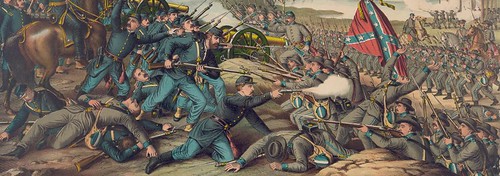The Battle of Chaffin’s Farm is fought in the American Civil War.
The Battle of Chaffin’s Farm, also known as the Battle of New Market Heights, was a significant engagement during the American Civil War that took place on September 29-30, 1864, in Virginia. It was part of the larger Union offensive known as the Richmond-Petersburg Campaign, which aimed to capture the Confederate capital of Richmond.
Context: By the fall of 1864, the Civil War had been raging for over three years, and the Union Army of the Potomac, commanded by Lieutenant General Ulysses S. Grant, was besieging the Confederate capital of Richmond and the nearby city of Petersburg. The Union forces had been trying to break through the formidable Confederate defenses surrounding these cities for months.
Objective: The primary objective of the Union offensive at Chaffin’s Farm was to extend their lines to the north and west of Richmond and potentially cut off Confederate supply lines. This would put additional pressure on the Confederate defenders and inch the Union closer to capturing the capital.
Troop Composition: Union forces, primarily consisting of the XVIII Corps under Major General Benjamin Butler, launched the assault. They were joined by the United States Colored Troops (USCT), who played a significant role in the battle. The Confederate defenders were commanded by General Richard H. Anderson.
Assault on New Market Heights: On September 29, 1864, Union forces launched a frontal assault against entrenched Confederate positions at New Market Heights. The assault was particularly challenging due to the well-fortified Confederate lines and the open ground that the Union troops had to cross. Despite heavy casualties, the USCT units displayed incredible bravery and determination and managed to capture some sections of the Confederate defenses.
Success at Fort Harrison: Concurrently, another Union force attacked Fort Harrison, a key Confederate fortification defending Richmond. After fierce fighting, Union troops captured the fort on September 29. However, holding it proved to be a difficult task as Confederate counterattacks ensued.
Outcome: While the Union forces did make significant gains during the Battle of Chaffin’s Farm, they were unable to capitalize fully on their success. The Confederate defenders managed to contain the Union advance and launch counterattacks, preventing the complete breakthrough that Grant had hoped for. The battle resulted in heavy casualties on both sides.
Aftermath: The Battle of Chaffin’s Farm marked a significant episode in the Richmond-Petersburg Campaign. Although the Union forces failed to achieve a decisive victory, they did manage to extend their lines and tighten the siege of Richmond. The battle also highlighted the bravery and effectiveness of the United States Colored Troops, many of whom received commendations for their valor in the face of heavy enemy fire.




